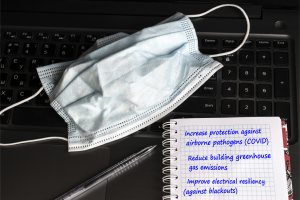Reconciling COVID-19 and Local Law 97
Posted on June 17th, 2021Reconciling COVID-19 and Local Law 97

For New York property owners and managers, the saying, “When it rains; it pours”, might be appropriate, unfortunately. Local Law 97 became effective in November 2019, and the COVID-19 pandemic struck little more than a year later. These events put property owners smack in the middle of a conundrum: reduce energy consumption and emissions for LL97 or protect against COVID-19 by improving indoor air quality which can increase energy consumption. The following describes the dilemma and offers some ideas to satisfy both challenges.
Local Law 97 (LL97)
LL97 or the New York City Climate Mobilization Act (CMA) of 2019 may be unfamiliar to those not involved in the New York property management industry; however, the intent may be familiar. The City’s stated goal was to reduce citywide emissions by 40% by 2030 and by 80% in 2050. Buildings were identified as a significant source of greenhouse gas emissions.
Over several decades, New York City enacted a long list of legislation aimed at reducing building energy consumption and emissions. One law made it a requirement that owners of buildings over 50,000 sq. ft. must annually report (called “benchmarking”) all forms of energy consumption. When the regulation was subsequently changed to include buildings over 25,000 sq.ft., more than 20,000 buildings in the five boroughs were required to submit reports.
With a mechanism in place to monitor building energy use, the next logical step was to establish limits on building emissions… with associated fines for failure to comply, of course. That step was called Local Law 97.
COVID-19
A typical approach to reducing energy consumption in New York to comply with LL97 would be to tighten up a building’s envelope to reduce air infiltration and heat loss. However, that approach does not line up with the recommendations for buildings during the pandemic. The advice for building owners from the Center for Disease Control (CDC), as of April 2021, for reducing airborne infectious aerosol exposure includes a variety of measures that may increase energy consumption, including:
- Using MERV 13 or better filtration
- Increasing outdoor air to as much as 100%
- Using standalone HEPA filtration, as needed
- Running HVAC system with maximum outside air for 2 hours before and after occupied
- Increasing distance between employees – more floorspace
Purchased Electricity
A peculiarity of LL97 is the fact that purchased electricity incurs a higher emissions penalty than that for natural gas consumption. It may seem counterintuitive but one way to reduce building emissions calculated under LL97 is to reduce the amount of electricity purchased by generating it on-site. This seeming inconsistency does make sense if overall energy efficiencies are considered.
Large electrical generating plants, including coal-, nuclear- and natural gas-fired, operate with average thermal efficiencies that range from 32% to 40%. This means some 60% to 68% of the energy used in these plants ends up being wasted heat. The electricity moving from a generating plant through the transmission and distribution system typically
loses an additional 5% to 10% by the time it reaches the consumer. This all results in an average overall energy efficiency of fuel used to electricity consumed of roughly 22% to 35% for large generating plants.
On-site co-generation increases overall energy efficiency by utilizing the heat generated and eliminating the electrical transmission losses. Rather than disposing of heat, co-generation will use it to produce hot water or steam or for any other type of heating application. All of this puts the typical overall energy efficiency of a co-generation system in the realm of 70+%, depending on a whole host of factors. It also means that cogeneration produces far fewer emissions per unit of energy than electricity purchased from the local utility.
Reconciling LL97 and COVID-19
Taken as a whole, the COVID-19 guidance means only one thing for building owners: increased energy use. Outside air adds to a building’s heating or cooling load while higher efficiency filters increase air pressure drop which requires more fan horsepower and more electricity to overcome. Running standalone filters and flushing unoccupied spaces takes more electricity. Even spacing people further apart can increase heating and cooling loads plus the need for additional lighting.
Implementing the COVID-19 guidelines can significantly increase the amount of electricity purchased and raise the LL97 calculated emissions of a building. This increased electrical load tends to make co-generation even more attractive in terms of lower energy consumption and potentially lowering the risk for LL97 emissions penalties. Furthermore, co-generation substantially increases a facility’s electrical resilience from blackouts and may even be designed to use otherwise wasted heat to pre-condition incoming outside air.
Get Expert Advice
When you need help understanding how to deal with building indoor air quality relative to COVID-19 and/or New York Local Law 97, MEP Services is your single source for answers. We give you a broad and detailed view of LL97 on our website: https://www.newyorkbuildingenergy.com and keep you updated with email alerts about critical developments in the law. Our engineers and technical and project professionals can also help you assess your options for tackling both LL97 and COVID-19.
Call Equans MEP Services for a free consultation on options for reconciling building emissions and indoor air quality.
